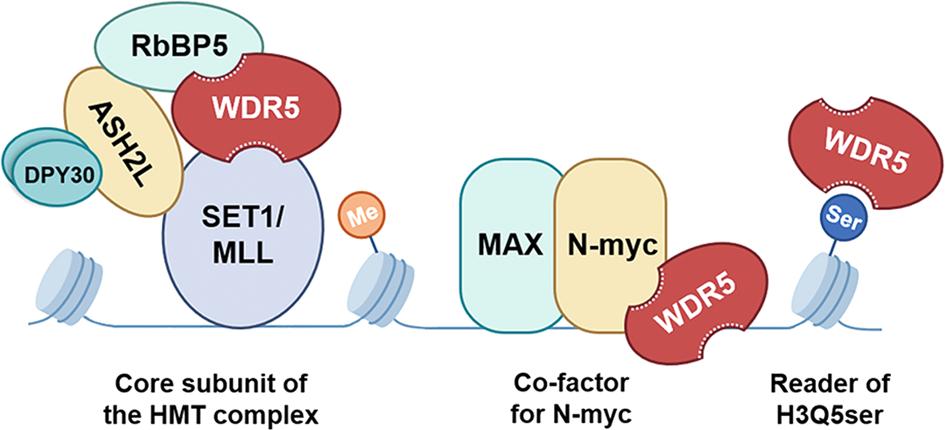What is WDR5 Protein
WDR5, formally known as WD Repeat Domain 5, stands as a crucial player in the intricate landscape of cellular processes. Also referred to by the aliases BIG-3, HBP23, and MYST3, WDR5 is a member of the WD-repeat protein family, characterized by its repeating sequence of tryptophan (W) and aspartic acid (D) residues. Its official full name, WD Repeat Domain 5, aptly reflects its structural composition.
WDR5 Protein Structural Characteristics and Classification
Structurally, WDR5 boasts a unique architecture that includes seven WD40 repeats, forming a propeller-like structure. These repeats serve as a scaffold for protein-protein interactions, playing a pivotal role in the assembly of multiprotein complexes. This structural characteristic places WDR5 at the crossroads of diverse cellular pathways, making it a subject of extensive research.
Recent Research Advances about WDR5 Protein
Recent advances in WDR5 research have shed light on its role in epigenetic regulation. Specifically, WDR5 has been identified as a key component of the MLL (Mixed-Lineage Leukemia) histone methyltransferase complex. This complex plays a crucial role in modulating gene expression, particularly in the context of embryonic development and hematopoiesis.
WDR5 Biological Functions and Molecular Mechanisms
The biological functions of WDR5 are multifaceted, reflecting its involvement in various cellular processes. One of its primary roles is as a core component of the MLL complex, where it acts as a scaffold for the complex's assembly. The MLL complex, in turn, catalyzes the methylation of histone H3 at lysine 4 (H3K4), a modification associated with active gene transcription.
Beyond its role in epigenetic regulation, WDR5 has been implicated in cell cycle progression, where it facilitates the expression of genes crucial for cell proliferation. Additionally, WDR5 contributes to DNA damage repair, ensuring the integrity of the genome.
At the molecular level, WDR5's functions are intricately linked to its ability to interact with various partners, including other components of the MLL complex and regulatory proteins. These interactions orchestrate a molecular symphony that influences gene expression patterns and cellular outcomes.

Figure 1. Schematic illustration of WDR5 function in neuroblastoma tumorigenesis. (Han Q, et al., 2023)
WDR5 Related Signaling Pathway
WDR5's involvement in signal pathways is intricately tied to its role in the MLL complex. The MLL complex, under the influence of WDR5, modulates the methylation status of histones, thereby regulating gene expression. This epigenetic control is a key node in cellular signaling, influencing processes ranging from cell cycle progression to DNA damage response.
In the context of cancer, the WDR5-MLL axis has emerged as a potential therapeutic target. Disrupting this pathway could offer a strategy to reprogram gene expression patterns in cancer cells, hindering their uncontrolled growth.
WDR5 Related Diseases
As with many proteins with diverse functions, dysregulation of WDR5 has been implicated in several diseases. Notably, aberrant WDR5 expression has been observed in various cancers, including leukemia, breast cancer, and prostate cancer. In these contexts, WDR5 often contributes to the dysregulation of gene expression, fueling uncontrolled cell growth and proliferation.
Furthermore, WDR5 has been implicated in neurological disorders, with studies highlighting its involvement in processes such as synaptic plasticity and neuronal differentiation. Dysregulation of WDR5 in these contexts may contribute to the pathogenesis of conditions like Alzheimer's disease and neurodevelopmental disorders.
WDR5's Applications in Biomedicine
The unique properties and functions of WDR5 position it as a promising player in biomedical applications. Researchers are exploring the potential of WDR5 in diagnostic development, leveraging its association with various diseases for biomarker discovery. Additionally, the intricate involvement of WDR5 in epigenetic regulation opens avenues for therapeutic interventions, with studies investigating its potential as a target for drug development.
In the realm of vaccine development, WDR5's role in immune response modulation is under scrutiny. Understanding its influence on immune pathways could pave the way for innovative vaccine strategies, enhancing the body's ability to mount an effective defense against pathogens.
In the field of therapeutics, targeting WDR5 holds promise for precision medicine approaches. Modulating its activity could provide a means to specifically influence gene expression patterns in diseases where WDR5 dysregulation plays a pivotal role.
Recommended Products
| Cat.# | Product name | Species | Source (Host) | Tag |
|---|---|---|---|---|
| WDR5-2734H | Recombinant Human WD Repeat Domain 5, His-tagged | Human | E.coli | His |
| WDR5-6871HF | Recombinant Full Length Human WDR5 Protein, GST-tagged | Human | In Vitro Cell Free System | GST |
| WDR5-244H | Recombinant Human WDR5 Protein, His-tagged | Human | E.coli | His |
| WDR5-3718H | Recombinant Human WDR5, GST-tagged | Human | E.coli | GST |
| WDR5-3556H | Recombinant Human WDR5 Protein (Met1-Lys120), His tagged | Human | E.coli | His |
| WDR5-31543TH | Recombinant Human WDR5, His-tagged | Human | E.coli | His |
| WDR5-007H | Recombinant Human WDR5 Protein | Human | E.coli | |
| WDR5-3719H | Recombinant Human WDR5 Protein, GST-tagged | Human | Wheat Germ | GST |
| WDR5-3760H | Recombinant Human WDR5 protein, His-SUMO-tagged | Human | E.coli | His-SUMO |
| Wdr5-1016M | Recombinant Mouse Wdr5 Protein, MYC/DDK-tagged | Mouse | HEK293T | MYC/DDK |
Reference
- Han Q, et al. Discovery, evaluation and mechanism study of WDR5-targeted small molecular inhibitors for neuroblastoma. Acta Pharmacologica Sinica. 2023, 44(4): 877-887.

